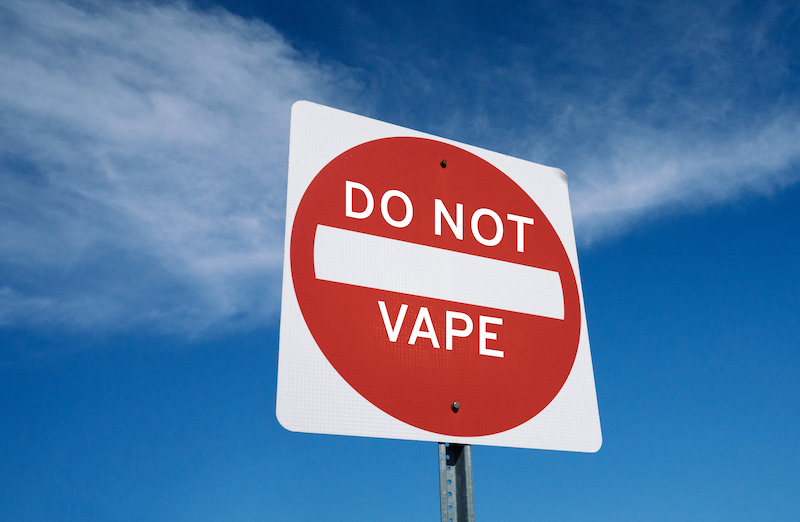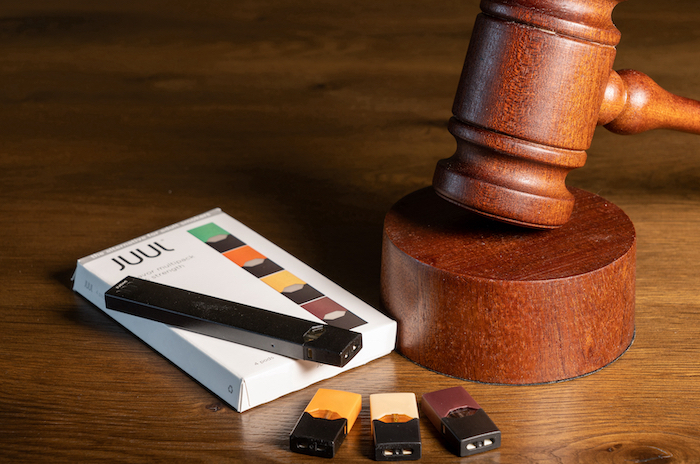The agency wants to make cigarettes less addictive and ban Juul vaping devices—but advocates want the big announcements to result in real action
By Jennifer Taylor
Nicotine has long been known as the source of addiction for smokers and e-cigarettes users. Just how much nicotine in such products is safe and appropriate? That’s what the U.S. Food and Drug Administration (FDA) is questioning after the agency last month published plans for future potential regulatory actions that would develop a product standard for cigarettes.
Days after that announcement, the FDA sent another strong message to the tobacco industry by banning the sale of all tobacco products manufactured by Juul Labs Inc., when it issued a marketing denial order (MDO) requiring the e-cigarette manufacturer to stop selling and distributing all of their products on the U.S. market. To legally market a new tobacco product in the U.S., a company must receive a written marketing order from the agency. Within 24 hours, Juul sued the FDA, and a federal court ruled on June 24 that Juul’s products can stay on the market for now. On July 5 the FDA itself stayed its ban while it reviewed the MDO.
The FDA’s actions on nicotine standards and Juul are “a good thing,” says Natalie Hemmerich, JD, MPH, of the Public Health Law Center (PHLC) in St. Paul, Minn. Hemmerich, a longtime advocate for tobacco control, acknowledges that while the FDA actions do not immediately impact the long-term effects that combustible cigarettes and e-cigarettes have on the population—for instance, the proposed product standard targets combustible cigarettes, not e-cigarettes—it shows some welcome initiative from the agency.
The FDA’s Proposed Non-addictive Standards
The idea that nicotine is used to create and sustain addiction to tobacco products is not a new issue for the FDA, nor is the idea of regulating its levels in the most harmful tobacco products, an FDA spokesperson told TreatmentMagazine.com. In 2018, the FDA tipped off the public on the idea of a product standard when it issued an advance notice of proposed rulemaking (ANPRM) seeking public comment on a nicotine product standard.
“The ANPRM noted the potential for profound public health benefits of making it harder for future generations to become addicted and allowing more current smokers to quit or switch to potentially less harmful products,” the spokesperson said, adding that regulation of nicotine levels is explicitly contemplated in the Tobacco Control Act, which identifies the issue of nicotine yields for agency consideration. The FDA is authorized to regulate nicotine levels through the rulemaking and comment process by proposing product standards.
“This action is aimed at doing the most that they can do—like taking the nicotine level down to a level so low that it’s no longer addictive. So it is one of the best things … the FDA can do to really reduce tobacco morbidity and mortality.”
Natalie Hemmerich, Public Health Law Center
The FDA is not, however, permitted to ban all tobacco products or even a certain class of tobacco products, like combustible cigarettes, Hemmerich says. It also cannot set a nicotine level at zero. But a potential product standard, Hemmerich says, is under its purview.
“This action is aimed at doing the most that they can do—like taking the nicotine level down to a level so low that it’s no longer addictive,” she says. “So it is one of the best things … the FDA can do to really reduce tobacco morbidity and mortality.”
How soon that will come under consideration, no one knows. The FDA spokesperson said there was no additional information on the content or timing of a proposed nicotine standard.
Still, the agency’s intentions were made clear in the Spring 2022 Unified Agenda of Regulatory and Deregulatory.
“This proposed rule is a tobacco product standard that would establish a maximum nicotine level in cigarettes and certain finished tobacco products. Because tobacco-related harms primarily result from addiction to products that repeatedly expose users to toxins, FDA would take this action to reduce addictiveness to certain tobacco products, thus giving addicted users a greater ability to quit,” it says.
Tobacco companies were wary of the proposal. Aaron Williams, senior vice president for scientific and regulatory affairs at Reynolds American, one of the nation’s biggest tobacco companies, told The Washington Post that the company is reviewing the proposal, and that it believes tobacco harm reduction is the best way forward to reduce the health impacts of smoking.
While the process remains open-ended, Hemmerich was encouraged.
“The idea is great,” she says. “The fact that they’re taking some kind of step toward is good.”
An FDA Ban and a Juul Lawsuit
Within hours of the FDA’s ban of Juul’s e-cigarettes, Juul sued the agency. A federal appeals court for the Washington D.C. Circuit ruled on June 24 that Juul’s products can stay on the market temporarily pending the court’s review.
The day before, the FDA declared that Juul’s products “must be removed or the company could face enforcement action,” the FDA announced in a press release. The products include the JUUL device and four types of JUULpods: Virginia tobacco flavored pods at nicotine concentrations of 5.0% and 3.0% and menthol-flavored pods at nicotine concentrations of 5.0% and 3.0%. The MDO only applies to the commercial distribution, importation and retail sales of Juul products. The FDA’s action does not restrict an individual consumer’s possession or use.

Again, Hemmerich praises the FDA’s action on Juul, characterizing it as “significant.” However, she notes that it lacked the impact it could have had a few years ago. Juul came under aggressive opposition by parents, minors, school leaders and legislators after its e-cigarettes touched off a nationwide youth vaping epidemic, peaking in 2018, that resulted in a new wave of teens becoming addicted to e-cigarettes, as well as hundreds of hospitalizations and dozens of reported deaths.
“This might not have long-term effects because Juul was already losing popularity among youth—as shown by the 2019 NYTS [National Youth Tobacco Survey] data,” Hemmerich says.
Curiously, Hemmerich notes, the FDA’s decision to ban Juul products was not based on the company’s problematic role in the youth e-cigarette epidemic. According to the FDA’s announcement, it’s because Juul didn’t submit sufficient data on toxicology.
“After reviewing the company’s premarket tobacco product applications (PMTAs), the FDA determined that the applications lacked sufficient evidence regarding the toxicological profile of the products to demonstrate that marketing of the products would be appropriate for the protection of the public health,” the FDA said in a press release. “In particular, some of the company’s study findings raised concerns due to insufficient and conflicting data—including regarding genotoxicity and potentially harmful chemicals leaching from the company’s proprietary e-liquid pods—that have not been adequately addressed and precluded the FDA from completing a full toxicological risk assessment of the products.”
For now, Juul products remain on the shelf.
“[It’s] unknown how long the litigation could last and whether we’ll actually see Juul taken off the shelves anytime soon,” Hemmerich says. “This was a big move for the FDA, though they are very litigation adverse, and they surely knew that denying those applications would result in litigation.”
Wanted: Action, Not Words
The grassroots organization Parents Against Vaping e-cigarettes (PAVe) praised the FDA’s Juul action, but the response was tempered by the legal squabbling to come. “The fact that Juul sued immediately and was granted a stay by the judge, immediately, is concerning,” PAVe co-founder Dorian Fuhrman told TreatmentMagazine.com. “These products have been allowed to remain on the market even after the FDA’s concerns over their safety. That signals to us that the deep pockets of the tobacco industry will sue any time a decision is made that is not in their favor. This is nothing new. The victory was short-lived.”
Still, PAVe vows to fight on. “We know there is enormous work to be done particularly given that JUUL has already launched a long and expensive legal battle,” the organization said on its website. “But we parents are not going anywhere.”
“What we want to see from this administration is: Don’t just make headlines. Actually do the things that you say you want.”
Natalie Hemmerich
In all likelihood, the FDA also knew that the back-to-back steps against the tobacco industry would make its usual splash in the news. Hemmerich hopes this time around it won’t be limited to that. During the Trump administration, she says, there were lots of big announcements that caught lots of headlines.
“Did we ever see any tangible action from it? No,” Hemmerich says. “What we want to see from this administration is: Don’t just make headlines. Actually do the things that you say you want.”
Top photo: Daniele Levis Peluse













